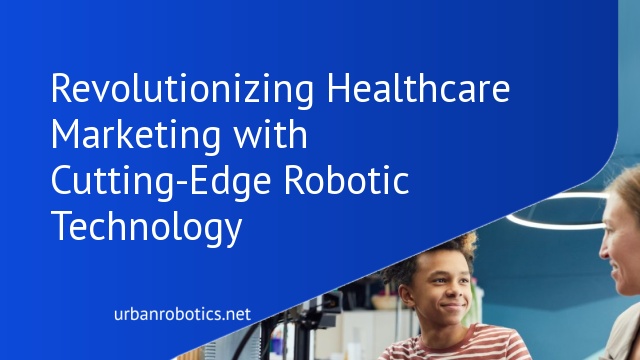The Evolution Of Healthcare Marketing
Healthcare marketing has come a long way, evolving from traditional methods to embrace cutting-edge technology. Initially, print advertisements and basic online presence were standard. Now, digital strategies dominate, leveraging social media, email campaigns, and SEO. As a result, organizations reach broader audiences with precision.
Robotic technology marks the latest frontier in this evolution. Integrating robots enhances marketing efficiency by automating data collection, mining insights, and tailoring campaigns. For instance, chatbots provide instant customer service, improving engagement and satisfaction. Robots also help segment audiences by analyzing large datasets, allowing us to create more targeted messages.
AI-powered robots drive predictive analytics, forecasting patient needs, and behaviors. This sophistication enables us to develop personalized campaigns that resonate with individual patients. Automation tools streamline administrative tasks, freeing up resources for creative strategy development.
By integrating robotic technology, healthcare marketing becomes more agile and responsive. We can adapt quickly to market changes, delivering timely and relevant content. This agile approach, combined with advanced robotics, positions us at the forefront of healthcare marketing innovation.
The Role Of Robotic Technology In Healthcare
Robotic technology is transforming healthcare marketing strategies, making processes more efficient and dynamic. Integration of robots in healthcare opens new possibilities for data analysis, patient interaction, and administrative automation.
Types Of Robotic Technologies In Healthcare
We see various robotic technologies in healthcare, including surgical robots, telepresence robots, and AI-driven robots. Surgical robots assist in precision procedures like laparoscopic surgery. Telepresence robots allow doctors to interact with patients remotely. AI-driven robots handle tasks such as sorting medical records and personalizing marketing campaigns. These technologies streamline operations and improve patient care.
Benefits Of Using Robots In Marketing
Robots elevate marketing efficiency by automating data collection and analysis. With robots, we can create highly customized campaigns based on predictive analytics. This allows us to deliver personalized content to patients, enhancing engagement. Moreover, robotic automation reduces administrative burdens, allowing healthcare providers to focus on patient care. Using robots in marketing leads to quicker decision-making and higher adaptability in an ever-evolving market landscape.
Strategies For Implementing Robotic Technology In Healthcare Marketing
Robotic technology revolutionizes healthcare marketing by improving personalization, customer engagement, and data analytics. Implementing these strategies will maximize efficiency and outcomes.
Personalization And Customer Engagement
Using robots, we can deliver highly personalized experiences to patients. AI-driven robots analyze patient data to create targeted content and recommend relevant services. For example, chatbots can provide instant responses to patient inquiries, enhancing engagement, and satisfaction. Additionally, robots can automate follow-up communications based on patient interactions, ensuring timely and personalized engagement without additional manual effort.
Data Collection And Analysis
Robots streamline data collection and analysis processes. They gather large volumes of patient data from various sources, ensuring comprehensive insights. AI algorithms help identify patterns and trends, which enables predictive analytics for future campaigns. By automating these processes, we gain accurate, up-to-date information, allowing quicker decision-making and more effective marketing strategies. For instance, robots can analyze response rates to tailor future marketing efforts, ensuring that our campaigns are always data-driven and impactful.
Case Studies Of Successful Implementation
Robotic technology is transforming healthcare marketing across the industry. Below, we analyze real-world cases highlighting successful adoption.
Hospital Chains Adopting Robotic Technology
Several renowned hospital chains, including Mayo Clinic and Cleveland Clinic, have integrated robotic technology into their marketing efforts. These institutions use AI-driven robots to automate patient feedback collection and social media management. For instance, Mayo Clinic’s implementation resulted in a 20% increase in patient engagement through personalized messaging. These systems enable hospitals to provide accurate, timely responses and capture valuable data for ongoing improvements.
Pharmaceutical Companies Leveraging Robotics
Pharmaceutical giants like Pfizer and Johnson & Johnson are harnessing robotics to enhance their marketing strategies. By using robots for data analysis and campaign optimization, Pfizer achieved a 15% improvement in targeted outreach effectiveness. Johnson & Johnson employ robotic technology to automate market research, reducing time spent on data collection by 30%. These innovations allow pharmaceutical companies to develop highly targeted campaigns that resonate with specific audiences.
Future Trends In Healthcare Marketing With Robotic Technology
Robotic technology is set to revolutionize healthcare marketing with several exciting trends. Autonomous robots will handle routine marketing tasks, freeing human teams to focus on strategy and creativity. Robots equipped with Natural Language Processing (NLP) will enhance customer interactions by offering real-time responses and personalized communication.
Predictive analytics powered by AI-driven robots will forecast patient behavior with greater accuracy. Hospitals and clinics will use these insights to tailor marketing efforts, increasing patient engagement and satisfaction. This technology improves the precision of targeted campaigns while reducing costs.
Robotic process automation (RPA) will automate back-end processes like data entry and reporting. This boosts efficiency and accuracy, minimizing human error. Pharma companies will benefit from faster market research and compliance checks.
Innovations in chatbot technology will further enhance patient interactions. Advanced chatbots can handle complex queries, schedule appointments, and provide medical information, all while gathering valuable data for marketing teams. This ensures patients receive timely and relevant information.
Developments in wearable robotics will expand data collection capabilities. Wearables will offer continuous health monitoring, feeding real-time data into marketing systems. This will enable hyper-personalized marketing strategies and proactive patient outreach.
These trends, driven by robotic technology, promise a future where healthcare marketing is more efficient, personalized, and impactful.
Conclusion
Healthcare marketing’s transformation with robotic technology is nothing short of revolutionary. By leveraging AI-powered robots, we can streamline marketing efforts and create more personalized patient experiences. The success stories from industry leaders like Mayo Clinic and Pfizer highlight the tangible benefits of integrating these technologies. As we look forward, the potential of autonomous robots, predictive analytics, and advanced chatbots promises even greater innovation. Embracing these advancements will undoubtedly set new standards in healthcare marketing, making it more efficient and impactful than ever before.





